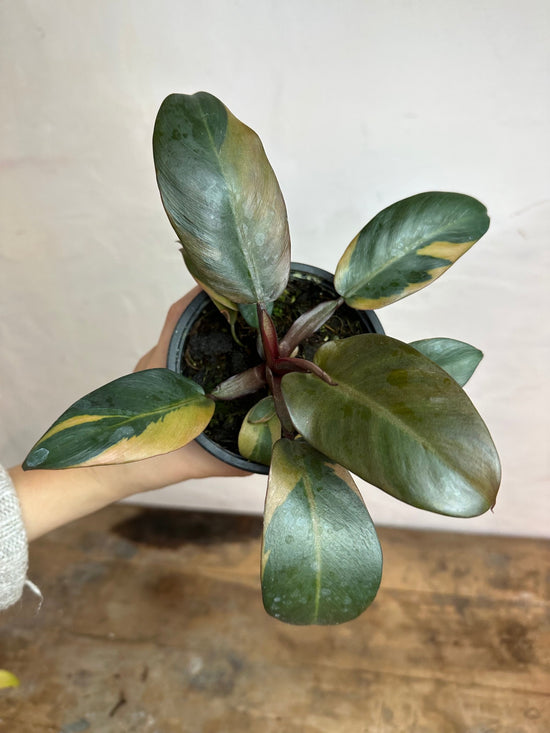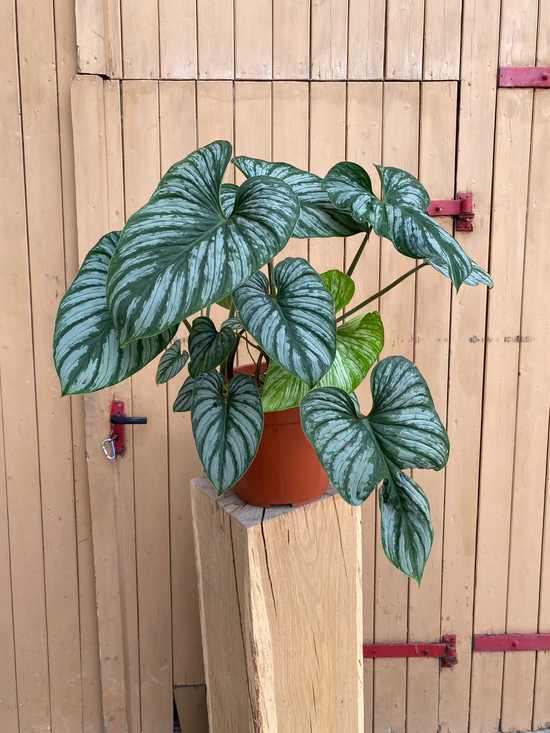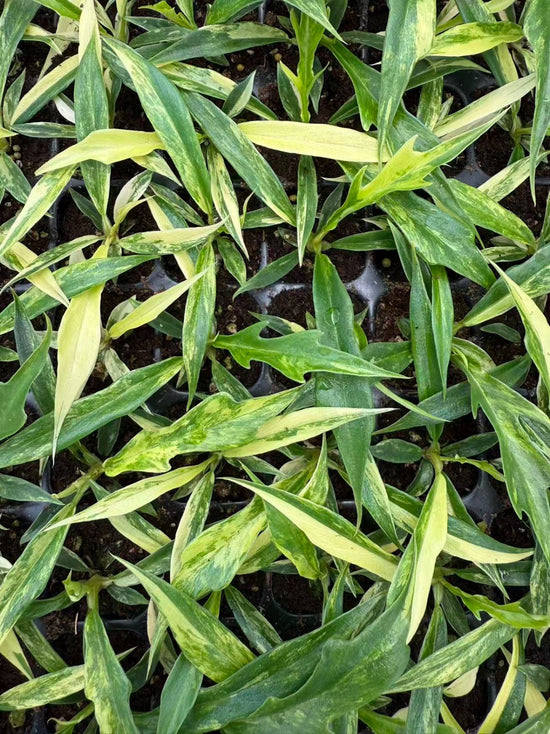67 products
-
Philodendron Black Cardinal Variegata M
 Vendor:Harmony PlantsPhilodendron Black Cardinal Variegata M
Vendor:Harmony PlantsPhilodendron Black Cardinal Variegata M- Regular price
-
€499,00 - Regular price
-
- Sale price
-
€499,00
-
Philodendron Mamei Silver Cloud XXL
 Vendor:Harmony PlantsPhilodendron Mamei Silver Cloud XXL
Vendor:Harmony PlantsPhilodendron Mamei Silver Cloud XXL- Regular price
-
€160,00 - Regular price
-
- Sale price
-
€160,00
-
Philodendron Tortum Variegata
 Vendor:Harmony PlantsPhilodendron Tortum Variegata
Vendor:Harmony PlantsPhilodendron Tortum Variegata- Regular price
-
€159,99 - Regular price
-
€249,00 - Sale price
-
€159,99
Philodendron species: The elegance of tropical leaves in your own home
Welcome to the Philodendron world of Harmony Plants, where every plant tells a story and brings green joy into your life! A Philodendron is a fascinating species from the Araceae family. These plants originally come from the lush rainforests of Central and South America, where they thrive in moist, shady environments. Today, Philodendrons are known worldwide as popular houseplants, captivating with their low-maintenance nature and decorative foliage. Philodendron, also known as the "tree friend," is enjoying great popularity as a fascinating houseplant.
Philodendron species
There are hundreds of Philodendron species – from timeless classic varieties to exotic variations, we offer a diverse selection. This impressive diversity is characterized by unique leaf shapes and adaptability. Whether you're an experienced plant lover or a beginner, a Philodendron will bring a touch of tropical beauty into your home. The Philodendron Gloriosum is particularly popular, impressing with its velvety, heart-shaped leaves and striking white leaf veins. The versatile Philodendron hederaceum, also known as the Heartleaf Philodendron, is particularly easy to care for and ideal for beginners. The numerous Variegata species are also very popular – their unusual patterns in shades of white, cream, pink, or yellow make each plant truly unique and a true eye-catcher. Be inspired by the unique characteristics and fascinating beauty of Philodendrons and find your personal favorite for your green home.
Philodendron growth forms: climbing, hanging or compact
Many Philodendron species are climbing plants that grow into trees in their natural habitat—hence the name "tree lover." With their aerial roots, they cling to trunks or trellises, making them perfect for vertical greenery in living spaces. Whether on a moss pole, trellis, or hanging in a pot, climbing Philodendrons bring life to any corner. There are also compact or bushy varieties that are ideal for shelves, sideboards, or smaller spaces. This diversity makes the Philodendron a true all-rounder among houseplants.
The leaves of the Philodendron
The most striking characteristic of the Philodendron is undoubtedly its leaves. Leaf shapes range from heart-shaped and deeply slit to arrow-shaped and almost sculptural—each species has its own unique charm. Typically, the leaves are a rich, glossy green, instantly adding a fresh, natural touch to any room. But many Philodendron species display far more than just classic green: Some species boast different shades of green—from deep emerald to delicate light green—creating exciting contrasts in the leaf structure.
The variegated Philodendron leaves are particularly fascinating, with their striking patterns and color gradients. White, cream, pink, or even yellow tones blend artfully with the green foliage, making each of these plants truly unique. The diverse color palette lends the Philodendron not only a tropical flair but also a timeless elegance that blends seamlessly into any interior.
Benefits of Philodendrons
Philodendrons are not only beautiful to look at, but also offer numerous benefits that make them an ideal choice for your home. Philodendron plants impress with their ability to purify indoor air by filtering out pollutants, thus contributing to a healthier indoor climate. Philodendrons are also extremely adaptable and can thrive in a variety of lighting conditions, whether in bright, indirect light or in shadier corners of your home. Their versatility is also evident in the way they can be grown: as climbers, creepers, or hanging plants. With a philodendron, you're not only bringing a decorative plant into your home but also a natural air purifier. Philodendrons are the perfect choice for plant lovers of all experience levels—low-maintenance yet impressive.
Care tips for your Philodendron
Philodendron care is straightforward and can be achieved with a few basic steps:
- Light : Philodendrons prefer bright, indirect light. They should not be exposed to direct sunlight, as this can cause leaf burn. A location near a bright window with slightly filtered light is ideal. They also tolerate partial shade or shade well, though growth may be somewhat slower in these locations.
- Humidity : Water your Philodendron moderately, allowing the soil to dry slightly between waterings to prevent root rot. Moderate humidity is appreciated, and occasional foliage misting can be helpful.
- Temperature : Keep the room temperature between 18°C and 24°C. Philodendrons are sensitive to sudden temperature changes and cold drafts.
-
Fertilization : During the growing season (spring and summer), fertilize your Philodendron approximately every 4-6 weeks with a balanced, liquid houseplant fertilizer. In winter, when growth is slower, reduce or skip fertilization.
- Repotting : Philodendrons don't need to be repotted often. However, if your plant grows too large for its pot or the roots begin to protrude from the pot, it's time to move it to a larger container with fresh potting soil.
- Cleaning : Occasionally wiping the leaves with a damp cloth helps remove dust and keep the pores of the leaves clear so they can breathe better.
If you would like to learn more about caring for philodendrons, visit our care guide for additional helpful tips – also for other plant species.
How to handle philodendrons safely
Although philodendrons are beautiful and easy-care houseplants, it is important to know that they can be toxic to cats, dogs and other pets. The plant contains calcium oxalate crystals, which can cause irritation and inflammation of the mucous membranes in the mouth and digestive tract if ingested. To ensure the safety of your pets, place philodendrons out of their reach. If you notice that your pet has nibbled on the leaves, seek veterinary attention immediately. With proper placement and caution, you can enjoy the beauty of philodendrons without endangering the health of your beloved pets.
Buy Philodendron online
Whether a timeless classic or a truly unique highlight, you'll find a wide variety of Philodendron species in our online shop. From popular climbers to unusual varieties with unique leaf shapes and color variations, there's something for every taste. If you're looking to buy a Philodendron, you're guaranteed to find the perfect plant for your collection with us. Order your Philodendron easily online and have it delivered safely and conveniently to your home.
Philodendron FAQ
Can I propagate my Philodendron?
Philodendrons are easy to propagate from cuttings . Simply cut a healthy stem and place it in water or moist soil until it forms roots. With these simple care tips, you can ensure your Philodendron plant grows healthy and lush.
How much light does my Philodendron need?
Philodendrons thrive in bright, indirect light—for example, near a window with a curtain or screen. Direct sunlight should be avoided, as it can burn the leaves. Pay attention to your philodendron's lighting requirements —both lack of light and light stress should be avoided. Thanks to their adaptability, many species also thrive in partially shaded locations.
Are philodendrons susceptible to pests and diseases?
Philodendrons are considered relatively hardy plants, but they can occasionally be attacked by pests or develop other health problems such as yellow leaves or brown tips. Check your plant regularly—especially the undersides of the leaves—and respond at the first signs with appropriate care and proper plant care.
Are philodendrons poisonous to humans?
Philodendrons are toxic to pets and small children if parts of the plant are ingested. The plants contain calcium oxalate crystals, which can cause irritation, burning, and nausea if they come into contact with the mouth and throat. Caution is especially advised with small children who tend to put things in their mouths. Adults are usually not at acute risk, but consumption should still be avoided.




